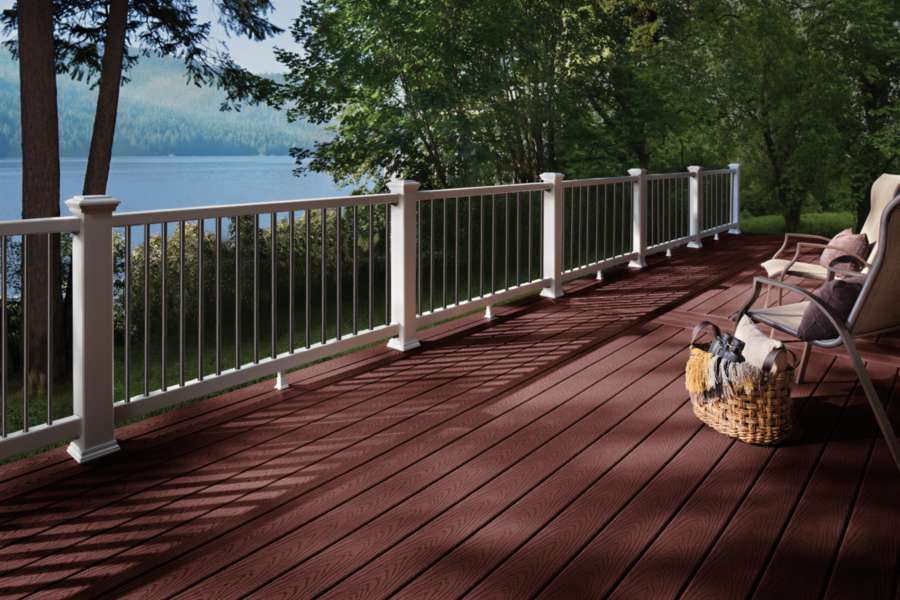We are often asked at the counter, “What is the best deck stain?” This question has different answers depending on the age of your deck, how much wood grain you want to show, the sun UV exposure of your deck, and how often you prefer to re-stain the deck.
Factors that Impact Even the Best Deck Stain
Stains are not a “one size fits all” product, so claiming there is an all-knowing, all-doing deck stain would be just plain wrong. That said, there are a few things that you should consider when choosing a deck stain that will help you find the best deck stain for you. You should ask yourself a few questions before making your decking material selections, like:
- How hot will my deck get?
- How exposed is my deck?
- How do I want my deck to look – light or dark?
These are all factors that will help you choose the best deck stain and material that suits your lifestyle.
UV Rays
The UV rays from the sun can be the harshest element to your deck. But, if your deck is on the north side or shaded, you may be battling mold and mildew. Stains with a moisture barrier will help to minimize mold and mildew problems.
As a general rule, the more pigment a stain has the more protected the deck is from the sun’s UV rays and the longer the stain should last. How much longer depends on the stain, if the project is vertical (siding or fence) or horizontal (decking) and the amount of sun exposure your project gets. Typically, vertical surfaces retain their stain longer than horizontal surfaces. Also, the more sun exposure your project gets, the quicker the stain will break down and need to be re-applied.
Clear Decking Sealant
Let’s begin with a clear sealer or natural finish. The clear sealer is often more preferred on new decks to show off the beauty of the wood. This type of stain usually has no or very little pigment. It allows the natural wood grain and tones to show through the best. Be prepared for the wood to naturally gray within a short amount of time.
The benefit of a clear finish is to provide a water repellent that helps minimize cracking and splitting at the wood surface. Due to clear sealers having very little UV Protection, you may find this type of stain needing attention and an additional coat more often than some of the other stains with more pigment and UV Protection. There are many types to choose from on the market.
The ones we prefer and carry in our store are:
- TWP® Clear in 100, 200 and 1500 series.
- Cabot® Wood-Toned Stain in Natural, Cedar, Heartwood or Pacific Redwood.
- DEFY® EXTREME Wood Stain in Crystal Clear
Semi-Transparent Decking Stain
The next stain with more pigment is the semi-transparent stain. This stain still allows wood grain to show through, but has more pigment or stain color than the clear stains. Semi-transparent stains will hold up a little better to the sun’s UV rays while providing waterproofing protection. The semi-transparent stains, in general, last longer than the clear sealers.
The semi-transparent stain and semi-solid stains are recommended for most decks. There are many shades to choose and several good semi-transparent stains on the market.
We prefer and carry the following semi-transparent stains:
- TWP® 100, 200, and 1500 series – mainly in the browns, red and gray family tones. Can be used on vertical or horizontal surfaces. This is an oil-based stain. The 1500 series is a low VOC version of the 100 series.
- Cabot® Semi-Transparent Stains – Oil based for decks and siding which can be used on horizontal or vertical surfaces. Acrylic-based for siding or vertical surfaces. Cabot semi-transparent stain has a wide variety of color tones to choose, including but not limited to beige, taupe, greens, blues, reds, and grays.
- DEFY® EXTREME Wood Stain – Water-Based in an array of colors in the brown, red, and gray family tones. This stain is fortified with Nano Particle Technology that helps block the UV Rays. Although this is a water-based stain, the wood still needs to be fully dry before applying the stain.
Semi-Solid Decking Stains
Then there are semi-solid stains. The semi-solid stain has more pigment than the semi-transparent stain allowing less grain to show through the stain. When going with a certain brand, the semi-solid will have more UV Protection than the semi-transparent. But the level of UV Protection of various brands may be different. And like semi-transparent stains, there are many colors to choose.
Here are the semi-solid stains we prefer:
- Cabot® Semi-Solid 1400 Series Stain – Linseed oil-based stain for decks and siding which can be used on horizontal or vertical surfaces. Cabot semi-solid 1400 series stain has a wide variety of color tones to choose from, including but not limited to beiges, taupes, greens, blues, reds, and grays.
Solid Decking Stain
The solid stains will have the most pigment and the most UV Protection. Solid stain is recommended for older and more weathered decks. But solids will wear different than semi-transparent and semi-solid stains; often times behaving more like paint than a stain.
Although solid stains have the most UV Protection, there will be no wood grain appearing through a solid stain. It is highly recommended to use a primer underneath a solid stain. Solid stains come in a wide range of colors.
We recommend the following brands for a solid stain:
- Cabot® Solid Stain comes in acrylic and oil-based. The 1600 and 1800 series stains are recommended for decking and other horizontal surfaces. The 1600 series stain is an alkyd oil-based stain. It is recommended to use 2 coats of the 1600 series with the first coat acting as the primer. The 1800 series stain is 100% acrylic based. For the acrylic-based stain, it is recommended to first put Cabot® Problem-Solver primer on before the stain. The 800 and 6500 series stains are recommended for siding and other vertical surfaces. The 800 series is a 100% acrylic stain and the 6500 series is an oil-based stain, a blend of tough alkyd resin and linseed oil. Cabot provides a wide variety of colors.
Preparation for Staining Your Deck
Here are some suggestions to keep in mind when planning to stain. Make sure the deck is dry to at least below 19% moisture level. If using our KDAT (kiln-dried after treatment) treated lumber, Cedar or Ipe decking, the lumber should already be below this moisture level.
It is recommended to stain and seal the deck as soon as it is installed for all kiln-dried decking material. If you have an older deck, weathered deck, or a deck that has had stain in the past few years, it is recommended to clean the deck with a deck cleaner/brightener before re-staining.
Along with cleaning off any dirt and debris, most deck cleaners and brighteners on the market will also deep clean any mildew and algae lingering down in the board’s surface cracks. Make sure the surface of the deck is dry and there has been no moisture on the deck in the past 48 hours prior to applying the stain.
Most exterior stains recommend the temperature to be between 50 and 90 degrees Fahrenheit. Coverage, drying time and clean-up will vary from stain to stain. Please always review the instructions on the back of the stain can you choose to obtain the best results for your project.
How Can Capitol City Lumber in Raleigh Help
We carry a few products that can be used on new construction including decks (end-cuts), handrails, fences and untreated storm doors. These products are water repellent and wood preservatives to protect wood from rot, decay as well as premature checking and cracking. These products are designed to be put on prior to the first staining or painting to provide better aging of your wood structure.
We recommend OUTLAST Q8 LogOil® for end-cuts on all treated lumber and all other untreated wood or Woodlife Classic made by Rustoleum® for any untreated wood. Both of these products are designed to be top coated with an acrylic or oil base stain or primed and painted.
Final Word: Best Deck Stain
If you’re still wondering what the best deck stain is for your setup, contact one of our lumber yard experts. Our team can help you decide which stain will leave you happy and comfortable for years to come.
This article was written for the customers of:
CAPITOL CITY LUMBER COMPANY
4216 Beryl Road
Raleigh, NC 27606
800-244-6492
Written by: Edie Morse



